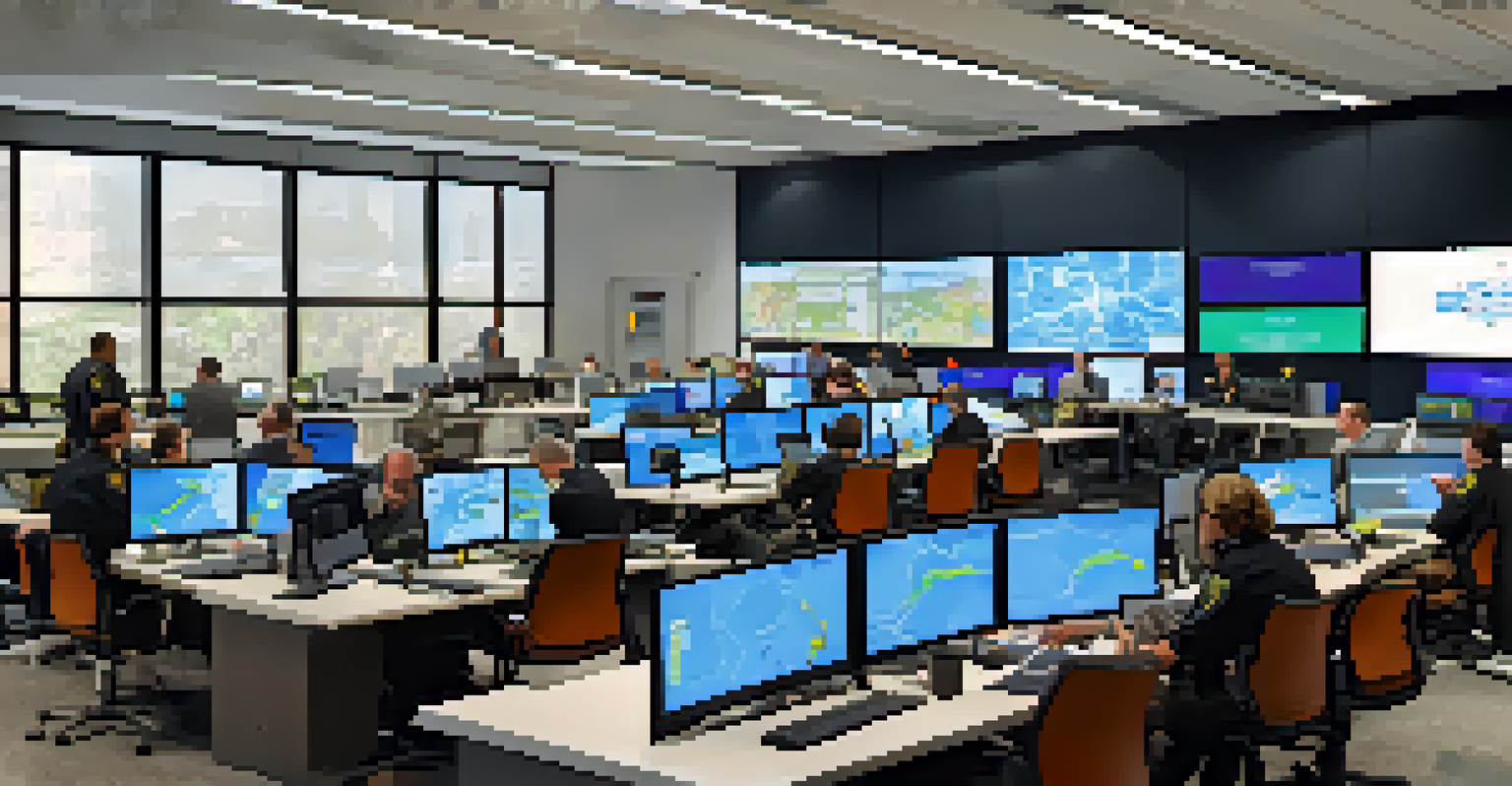Understanding the NYC Emergency Management System for Crises

What is the NYC Emergency Management System?
The NYC Emergency Management System is designed to prepare for, respond to, and recover from emergencies. It encompasses various agencies and organizations working together to ensure public safety during crises. By coordinating efforts, the system aims to minimize the impact of disasters and protect New Yorkers.
By failing to prepare, you are preparing to fail.
Understanding this system means recognizing its layered approach, which includes planning, training, and community engagement. Each of these components plays a crucial role in ensuring that the city can respond effectively when a crisis occurs. For example, regular drills and simulations help prepare both emergency responders and the community for potential scenarios.
Moreover, the system is adaptable, allowing it to evolve as new threats emerge, from natural disasters to public health emergencies. This flexibility is vital for maintaining resilience in a city as dynamic as New York. By staying ahead of potential issues, the NYC Emergency Management System aims to keep residents safe and informed.
Key Agencies Involved in Emergency Management
Several key agencies play a vital role in the NYC Emergency Management System. The New York City Emergency Management Department is at the forefront, coordinating efforts among various city agencies and stakeholders. Other agencies, such as the Fire Department and the Police Department, also contribute their expertise during emergencies.

Additionally, non-governmental organizations and community groups are integral to the system. They provide support and resources, ensuring that vulnerable populations receive assistance during crises. For instance, local charities often mobilize quickly to provide food and shelter after disasters, showcasing the power of community collaboration.
Preparedness is Key to Resilience
The NYC Emergency Management System emphasizes preparedness through planning, training, and community engagement to ensure effective responses during crises.
These agencies work together under a unified command structure that enhances communication and efficiency. This collaborative approach ensures that resources are allocated effectively and that all team members are on the same page. Ultimately, it helps create a more resilient city that can bounce back from adversity.
The Role of Preparedness in Crisis Management
Preparedness is a cornerstone of the NYC Emergency Management System. It involves planning, training, and equipping both responders and the community to handle emergencies effectively. This proactive approach helps reduce panic and confusion when a crisis strikes, allowing for a more organized response.
In the midst of chaos, there is also opportunity.
One example of preparedness in action is the Ready NYC program, which encourages residents to create emergency plans and build disaster supply kits. By engaging the public in these efforts, the city fosters a culture of readiness that empowers individuals to take charge of their safety. This is particularly important in a densely populated area where resources can become stretched during emergencies.
Moreover, ongoing training for emergency personnel ensures that they are well-prepared for various scenarios. Regular exercises, simulations, and workshops help responders hone their skills and maintain a high level of readiness. This commitment to preparedness ultimately strengthens the city’s overall resilience.
How the Public Can Stay Informed During Crises
Staying informed is crucial during a crisis, and the NYC Emergency Management System provides multiple channels for communication. Alerts and updates are disseminated through various platforms, including social media, text messages, and the Notify NYC app. This ensures that residents receive timely information about emergencies, safety measures, and resources.
Additionally, public service announcements and community meetings help keep New Yorkers informed about ongoing efforts and preparedness initiatives. Engaging the community fosters a sense of collaboration and encourages individuals to share information with one another. This grassroots approach can be essential during emergencies when quick communication is necessary.
Emergency Management System Overview
The NYC Emergency Management System coordinates various agencies to prepare for, respond to, and recover from emergencies, ensuring public safety.
Furthermore, the city encourages residents to sign up for emergency alerts tailored to their neighborhoods. By being proactive and informed, individuals can better protect themselves and their families during crises. Knowledge truly is power, especially in times of uncertainty.
Understanding the Types of Emergencies in NYC
New York City faces a variety of emergencies, ranging from natural disasters to public health crises. Hurricanes, blizzards, and flooding are just a few examples of weather-related events that can impact the city. Each type of emergency requires a different response strategy, highlighting the need for a well-rounded emergency management system.
In addition to natural disasters, public health emergencies, such as pandemics, pose unique challenges. The COVID-19 pandemic showcased the importance of coordination among health agencies, emergency responders, and the community. This experience underscored the necessity of being prepared for a range of potential crises beyond just physical disasters.
Understanding these different types of emergencies helps residents appreciate the complexity of emergency management. It also emphasizes the importance of being prepared for any scenario. By recognizing the potential risks, individuals can take steps to safeguard themselves and their loved ones.
Community Engagement in Emergency Preparedness
Community engagement is a vital component of the NYC Emergency Management System. By involving residents in preparedness initiatives, the city fosters a culture of resilience. Programs like Community Emergency Response Teams (CERT) train volunteers to assist during emergencies, enhancing local support networks.
These teams empower individuals to take action in their neighborhoods, whether by helping with evacuations or providing first aid. This grassroots approach not only strengthens community bonds but also ensures that assistance is available where it's needed most. It's a prime example of how local engagement can make a significant difference during crises.
Community Engagement is Key
Involving residents in preparedness initiatives through programs like Community Emergency Response Teams enhances resilience and local support during crises.
Moreover, the city hosts workshops and events to educate residents on emergency preparedness. By providing resources and information, the city encourages proactive behavior among its citizens. Ultimately, a well-informed community is better equipped to respond to emergencies and recover quickly.
The Importance of Recovery After a Crisis
Recovery is often the most overlooked phase of emergency management, yet it is crucial for communities to rebound after a crisis. The NYC Emergency Management System places significant emphasis on recovery efforts to restore normalcy and support affected residents. This phase involves not only rebuilding infrastructure but also addressing the emotional and psychological needs of those impacted.
For instance, mental health support is an essential part of recovery, helping individuals cope with the aftermath of disasters. The city collaborates with various organizations to provide counseling and resources to those in need. By acknowledging the emotional toll of emergencies, the system fosters a more comprehensive recovery process.

Additionally, long-term recovery planning ensures that the city is better prepared for future crises. Learning from past experiences helps refine strategies and improve resilience. This commitment to recovery reflects the city’s dedication to its residents and their well-being, ensuring that they emerge stronger from any challenge.
Future Challenges for NYC Emergency Management
As New York City continues to grow and evolve, so too do the challenges faced by its Emergency Management System. Climate change, population density, and emerging technologies present both opportunities and hurdles. Addressing these challenges requires innovative thinking and collaboration among various stakeholders.
For instance, rising sea levels pose a significant risk to coastal areas, necessitating enhanced infrastructure and preparedness measures. The city is actively exploring solutions, such as flood barriers and improved drainage systems. These proactive steps demonstrate the commitment to safeguarding the city while adapting to changing circumstances.
Importance of Recovery Efforts
Recovery is essential for restoring normalcy after a crisis, focusing on both infrastructure rebuilding and addressing the emotional needs of affected residents.
Moreover, advancements in technology can improve emergency response but also introduce new complexities. Cybersecurity threats, for example, challenge the integrity of critical systems. As the NYC Emergency Management System navigates these future challenges, ongoing adaptation and community involvement will be essential for success.